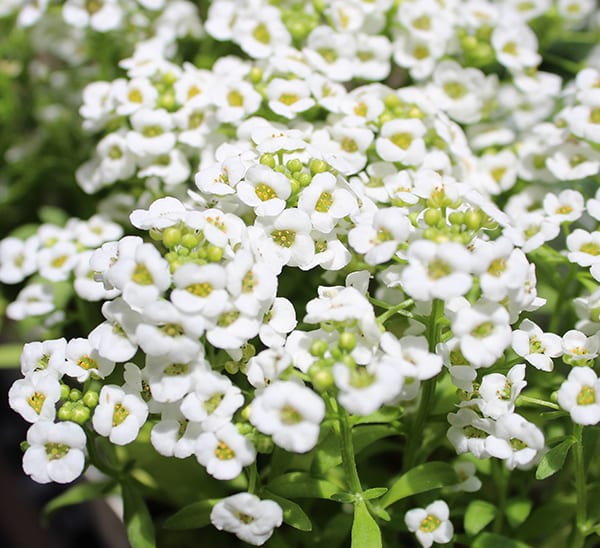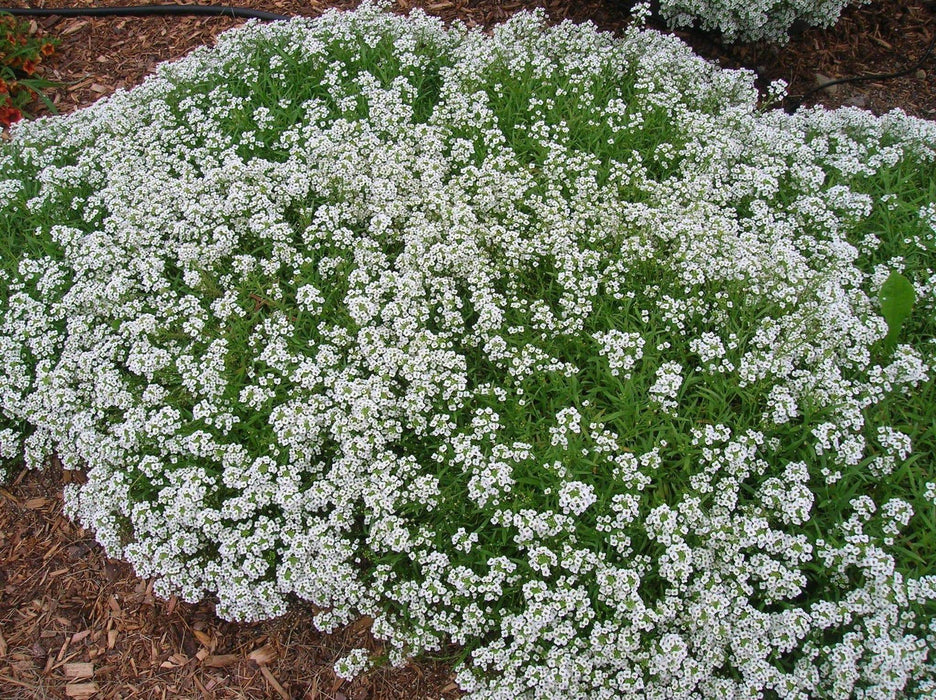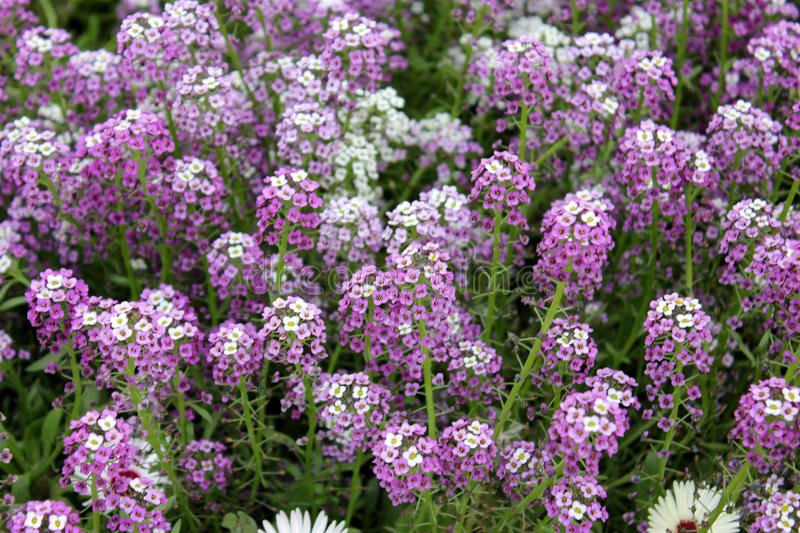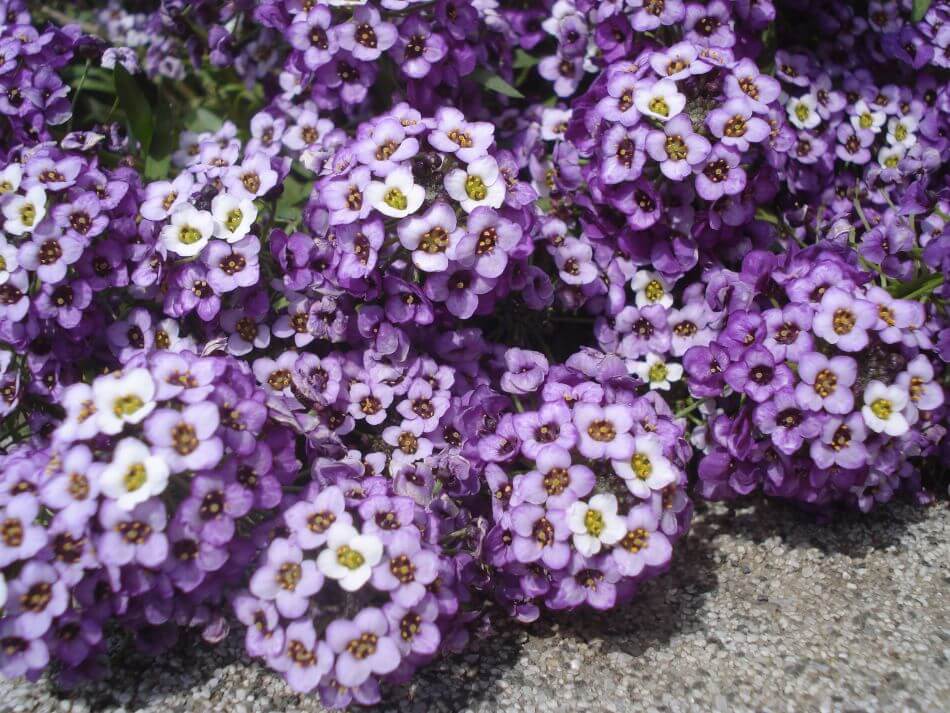
Sweet alyssum

Sweet alyssum is a cool-season annual with dainty blossoms on tidy mounds of foliage.
Sweet alyssum flowers are most often found in a crisp, clean white. However, sometimes you’ll see deep purple, light pink, or even soft peachy-hued varieties. The abundant white blooms go with everything. Sweet alyssum is valued for its early spring flowers.

Sweet Alyssum Overview
| GENUS NAME | Lobularia maritima |
| COMMON NAME | Sweet Alyssum |
| PLANT TYPE | Annual |
| LIGHT | Part Sun, Sun |
| HEIGHT | 4 to 12 inches |
| WIDTH | 12 to 18 inches |
| FLOWER COLOR | Pink, Purple, White |
| FOLIAGE COLOR | Blue/Green |
| SEASON FEATURES | Fall Bloom, Spring Bloom, Summer Bloom |
| SPECIAL FEATURES | Fragrance, Good for Containers, Low Maintenance |
| ZONES | 5, 6, 7, 8, 9 |
| PROPAGATION | Seed, Stem Cuttings |
| PROBLEM SOLVERS | Groundcover |
Where to Plant Sweet Alyssum
Plant sweet alyssum in a place where it gets full sun although in warmer climates partial shade is also acceptable. The plant is undemanding in terms of soil quality and pH (slightly acidic to neutral is ideal) but it needs excellent drainage.
Sweet alyssum shines in locations where you want a carpet of flowers, either as an edging plant, as a filler between walkway stones, or as a groundcover between taller plants, as long as you give it enough space; it does not like to be in a crowded garden bed.
Sweet alyssum needs good air circulation, which makes it a great choice for containers and hanging baskets.
How and When to Plant Sweet Alyssum
Alyssums are easy plants to start from seed. Because they’re cool-season annuals, they can be sown directly in a sunny spot in your garden a few weeks before the last frost date for your area.
If you want an even quicker impact in your garden, start seeds indoors 5 to 6 weeks before planting. This helps extend your bloom time a little longer.
Potted specimens require a planting hole roughly twice the size of their root ball, planted at the same depth as it is in the pot, a deep watering at planting time, and regular watering intervals as the roots take hold. Give sweet alyssum 6 to 12 inches between plants to keep them from getting crowded.
Sweet Alyssum Care Tips
Sweet alyssum will grow abundantly without too much help or care.

Light
Be sure your alyssums get plenty of sunshine. In northern climates with mild summers, full sun is ideal, allowing plants to keep blooming as much as possible. In areas where summers are warmer, plant alyssums in part shade, especially to protect them from the hot afternoon sun.

Soil and Water
Sweet alyssum needs well-drained soil with a pH between 6.0 to 7.0. It does best if kept evenly moist throughout the season and should be watered in dry weather.
Temperature and Humidity
Sweet alyssums don’t mind the cold, as long as it isn’t a hard freeze. Because alyssum is a cool-season annual, plants will generally stop blooming to conserve energy in the summer. However, some varieties are much more tolerant of the heat and will give you more bloom time. In most cases, those with darker-colored blossoms tend to have less heat resistance than the pure white varieties.
Fertilizer
Sweet alyssum planted in the garden doesn’t need fertilizer unless the soil is lacking in nutrients. Alyssum in pots should be fertilized monthly with a complete balanced fertilizer.

Pruning
If the season gets too hot and plants stop blooming, shear plants back by about half. This will encourage new growth and give your plants a good base to bloom once cool weather returns in fall.
Potting and Repotting Sweet Alyssum
Because sweet alyssum needs soil with excellent drainage, it is important to plant it in a container with large drainage holes. Using a tall container or a hanging basket best accommodate its trailing growth habit, and fill it with well-draining potting mix.
Since alyssum is usually grown as an annual whose life cycle ends with killing fall frosts, it won’t need repotting.

Pests and Problems
A common problem of sweet alyssum is downy mildew and root rot due to poorly draining soil. It’s very rarely bothered by garden pests. Curling leaves on your sweet alyssum might indicate the plant has cyclamen mites. These tiny sap-sucking insects are hard to see without a magnifying glass. Treat the plant with neem oil or insecticidal soap to get rid of them.
How to Propagate Sweet Alyssum
Sweet alyssum is propagated from seed. While you can direct sow in warmer climates, starting it in pots gives you better control over the germination. In cold climates, it also gives you a head start on the growing season.
Start the seeds 4 to 5 weeks before the last average frost date in your area. Place the seeds in pots filled with potting mix and gently press the seeds into the soil; do not cover them, as they need light to germinate. Keep the seeds moist at all times. Harden the seedlings off at temperatures between 50 and 55 degrees F before transplanting them outdoors after the last frost.
Types of Sweet Alyssum
‘Clear Crystal Lavender Shades’ Sweet Alyssum
:strip_icc():format(webp)/clear-crystal-lavender-sweet-alyssum-536bab10-31c551b338ff4a52bdf70f3aa50b214e.jpg)
Lobularia maritima ‘Clear Crystal Lavender Shades’ is an extra-vigorous selection with fragrant, larger-than-typical lavender blooms. It grows 10 inches tall and 14 inches wide.
‘Easter Bonnet’ Sweet Alyssum
:strip_icc():format(webp)/sweet-alyssum-17638494-b897d703ba344d3d88552913b168f880.jpg)
Lobularia maritima ‘Easter Bonnet Pastel Mix’ offers soft pink, lavender, and white blooms on tidy 4-inch-tall plants.
‘Frosty Knight’ Sweet Alyssum
:strip_icc():format(webp)/frosty-knight-sweet-alyssum-4ad2040c-3a23d99e27a14e7e896600666160675d.jpg)
Lobularia ‘Frosty Knight’ is a novel variety with cream-edged green leaves as an added bonus to the bountiful white blooms.
‘Snow Crystals’ Sweet Alyssum
:strip_icc():format(webp)/snow-crystals-sweet-alyssum-d6785fb1-eff5238babf14dfe8a2bd56bc99fe9f3.jpg)
Lobularia maritima ‘Snow Crystals’ has fragrant, extra-large flowers on vigorous plants.
‘Snow Princess’ Sweet Alyssum
:strip_icc():format(webp)/snow-princess-sweet-alyssum-9c4a89e0-b0bbbad3c6e94dafb6674830fa97b7c9.jpg)
Lobularia maritima ‘Snow Princess’ is an exceptionally vigorous variety that’s heat tolerant and bears clusters of white flowers much larger than older varieties. It’s very fragrant, as well, and grows 6 inches tall but can trail to 5 feet.
Sweet Alyssum Companion Plants
Nemesia
:strip_icc():format(webp)/nemesia-candy-girl-f4b6c42f-669a878a0d7e4aa3ae83917d850487dc.jpg)
Nemesia is a cool-season annual with pretty little snapdragon-shaped flowers—often fragrant—that bloom in a wide range of colors. It does best in spring and fall (and winter in mild-winter climates), though some varieties have better heat tolerance than others. In cool-summer areas, such as the Pacific Northwest, nemesia will continue to bloom right through the summer into fall. Zones 9-11
Pansy
:strip_icc():format(webp)/majestic-giant-pansies-22188e99-35b07d86399444c7842c043a3b55de73.jpg)
The genus Viola has an array of delightful plants for the spring garden. They don’t mind cold weather and can even take a little snow and ice. They’re pretty planted in masses in the ground but also appreciated for the early color they bring to pots, window boxes, and other containers. By summer, pansies bloom less, and their foliage starts to brown. When that happens, tear them out and replant warm-season annuals, such as marigolds or petunias. Zones 3-11
Stock
:strip_icc():format(webp)/red-pink-white-stock-geraniums-5086e845-fcd665dc940d4b3bb4b9f0edb07bab0e.jpg)
Stock offers a spicy, distinctive scent. Plant it in spring several weeks before your region’s last frost date; this annual thrives in cool temperatures and stops blooming once hot weather arrives. It’s especially wonderful in window boxes and planters at nose level, where its subtle effect can best be appreciated. Stock is slightly spirelike and comes in a wide range of colors. It makes an excellent cut flower, perfuming bouquets. Zones 7-10
Garden Plans for Sweet Alyssum
Small-Space Vegetable Garden Plan
:strip_icc():format(webp)/raised-bed-vegetable-garden-c1a973ba-6144a61f1f2a49eabe5a528b3c8bbb32.jpg)
Add great looks—and tastes—to your landscape with an easy small vegetable garden plan.
Drought-Tolerant Garden Plan
:strip_icc():format(webp)/backyard-garden-with-decorative-stone-birdbath-3a56c42e-e7e9eb8e908149aead9c9097a70c4dca.jpg)
This informal mixed garden bed features drought-tolerant trees, evergreen shrubs, perennials, and annuals.
Low-Water Garden Plan
:strip_icc():format(webp)/low-water-garden-plan-28821ba3-1a656b9e42644db7967970223aa90f73.jpg)
No matter where you live, it’s inevitable that plants will take defeats in the middle of July. Count on this easy-care garden to stay looking good through dry spells.
Edited by: Mino Ghafouri Sadatieh
Instagram address: gooldono.stand.sidoos@
Phone: 09308743868










